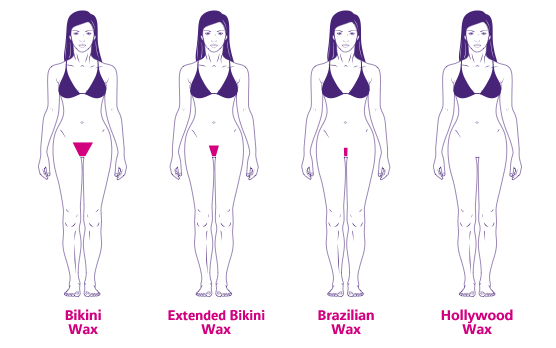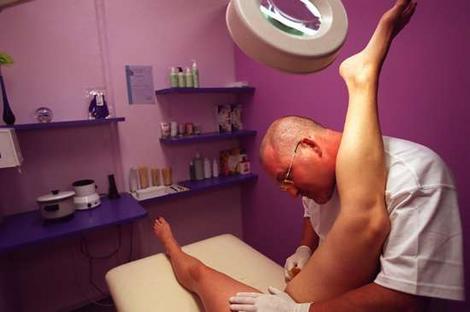Crab Lice Now an Endangered Species
Millions of Crab Lice Dead All Because of Brazilian Bikini Waxes
Pubic Crab lice, the crab-shaped insects that have dwelled in human groins since the beginning of history, are disappearing. Doctors say bikini waxing may be the reason.
Waning infestations of the bloodsuckers have been linked by doctors to pubic depilation, especially a technique popularized in the 1990s by a Manhattan salon run by seven Brazilian sisters. More than 80 percent of college students in the U.S. remove all or some of their pubic hair — part of a trend that’s increasing in western countries. In Australia, Sydney’s main sexual health clinic hasn’t seen a woman with pubic lice since 2008 and male cases have fallen 80 percent from about 100 a decade ago.
“It used to be extremely common; it’s now rarely seen,” said Basil Donovan, head of sexual health at the University of New South Wales’s Kirby Institute and a physician at the Sydney Sexual Health Centre. “Without doubt, it’s better grooming.”
The trend suggests an alternative way of stemming one of the globe’s most contagious sexually transmitted infections. Pubic lice are usually treated with topical insecticides, which once included toxic ones developed before and during World War 2. While they aren’t known to spread disease, itchy skin reactions and subsequent infections make pubic lice a hazardous pest. Clipping, waxing and shaving the groin destroy the optimal habitat of pubic lice. The practice has helped spur sales of depilatory products for companies such as Procter & Gamble Co. (PG)and Reckitt Benckiser Group Plc. (RB/)
P&G, Reckitt Benckiser
 The global market for depilatories was worth $4.69 billion last year, according to London-based Euromonitor International Ltd., which estimates sales increased at a 7.6 percent average annual clip the past decade. Cincinnati-based P&G, Slough, England-based Reckitt Benckiser and Energizer Holdings Inc. (ENR), based in St. Louis, dominate the market, which Euromonitor predicts will reach $5.6 billion by 2016.
The global market for depilatories was worth $4.69 billion last year, according to London-based Euromonitor International Ltd., which estimates sales increased at a 7.6 percent average annual clip the past decade. Cincinnati-based P&G, Slough, England-based Reckitt Benckiser and Energizer Holdings Inc. (ENR), based in St. Louis, dominate the market, which Euromonitor predicts will reach $5.6 billion by 2016.
A majority of college men and women in the U.S. and Australia remove all or part of their pubic hair, researchers at Kenyon College in Gambier, Ohio, reported in a 2011 paper, citing surveys and research by other scholars. In the U.K., 99 percent of women older than 16 years remove some hair, most commonly from the under arms, legs and pubic area, a 2005 study found.
Brazilian waxing took off internationally in the early 2000s, possibly spurred by the attention it was given on television shows such as Sex and the City, said Spring Cooper Robbins, a senior lecturer and sexual health researcher at the University of Sydney.
J Sisters Salon
About a block from New York’s famous Fifth Avenue shopping strip, women in fur coats and Louis Vuitton handbags are filing in and out of a beauty salon on a recent Friday afternoon. They perch on metallic silver and red floral sofas in the reception located in a Midtown Manhattan office building, waiting for a woman dressed in white to escort them to a waxing room.
The shop run by Jonice Padilha and her sisters Jocely, Janea, Joyce, Juracy, Jussara and Judeseia may be ground zero in the war on Crab Lice. Growing up in the Brazilian coastal city of Vitoria, the sisters, like other women there, routinely waxed their pubic hair off to accommodate the ever shrinking bikinis worn on the beach.
In 1994, they introduced the waxing technique at the J Sisters nail salon they opened in 1986. Things exploded from there, Padilha said.
About 200 clients a day, including celebrities such as Sarah Jessica Parker, come for treatments ranging from complete hair removal to custom designs. Regulars returning every four weeks pay $75 for a Brazilian. Men of all ages and sexual orientation are going for the “Sunga” wax, a $90 treatment in which all pubic hair, including on the testicles, is removed.
Hygiene and comfort are key reasons customers keep coming back, she said.
‘Environmental Disaster’
“It’s like a freedom,” said Padilha of the salon’s signature bikini wax treatment. “When we started the salon 26 years ago, we never thought it would be a success.”
Nor was it expected to aid in the fight against pubic lice, she said.
“Pubic grooming has led to a severe depletion of Crab Lice populations,” said Ian F. Burgess, a medical entomologist with Insect Research & Development Ltd. in Cambridge, England. “Add to that other aspects of body hair depilation, and you can see an environmental disaster in the making for this species.”
Pubic lice, known scientifically as Phthirus pubis, infest about 2 percent to 10 percent of the human population, researchers at East Carolina University said in a 2009 study.
Incidence data aren’t kept by the World Health Organization in Geneva because the gray, six-legged, millimeter-long louse doesn’t transmit disease, and national authorities such as the Centers for Disease Control and Prevention in Atlanta and U.K.’s Health Protection Agency don’t collect the information.
Lousy Data
Researchers instead track pubic-lice infestations from surveys and records kept by clinics such as Donovan’s, which receives about 35,000 annual patient-visits annually.
“Historically, it’s been very difficult to get incidence data on pubic lice simply because people don’t like to report it,” said Richard Russell, director of medical entomology at Sydney’s Westmead Hospital. “In over 40 years, I could count on two hands the number of people who had brought pubic lice in for identification and admitted to knowing what they were.”
A 2003 study of sexually transmitted infections in Australia found pubic lice was the most common symptom-causing ailment, with at least a third of people experiencing an infestation at some point in their life. Most people self-treat the problem with a topical lousacide bought from pharmacies, Donovan said.
Ten years ago, U.K. doctors noticed a dwindling in cases of pubic lice even as patient numbers and prevalence rates of other sexually transmitted infections increased.
Going Hairless

Janet Wilson, a consultant in sexual health and HIV, linked the trend with the growing popularity of pubic hair removal she and colleagues observed among patients attending the genitourinary medicine department at the General Infirmary in Leeds, northern England.
In a letter to a medical journal in 2006, they noted patients began getting a procedure known as the “Brazilian,” in which all but a small strip of hair is removed. Women and men who have sex with men took up the practice initially. Now, heterosexual men are doing so also, Wilson said.
She and colleagues are analyzing patient records to see if it’s lowered rates of pubic lice further, and will present their latest findings at a medical meeting in May, she said.
“We put the flag out, so to speak, if we see a case of pubic lice nowadays,” Wilson said in an e-mailed response to questions. “The ‘habitat destruction’ of the pubic lice is increasing and they are becoming an endangered species.”
Skin Trauma
One in seven American men ages 25 to 34 years have had their body hair waxed, according to a Mintel Group Ltd. report published in October 2011. “Now there are tutorials about the proper — and safe — way to shave the chest, arms, or groin depending on how hirsute the individual may be,” the report said. Waxing, shaving and plucking hair can cause skin trauma, breaching its protective barrier and potentially aiding the spread of other sexually transmitted infections, said Cooper Robbins at the University of Sydney. Non-sterile depilation products and procedures increase the infection risk.
A 20-year-old Australian woman with poorly controlled diabetes was hospitalized with a life-threatening bacterial infection of her genitalia following a routine Brazilian wax, doctors reported in 2007, noting a lack of published data on infectious risks.
Ingrown Hairs
“No matter what type of hair removal is used, there is the risk of ingrown hairs,” Cooper Robbins said. “That also creates the opportunity for infection.”
The female louse needs to mate only once to remain fertile throughout her lifetime and can lay eggs every day. Once hatched, the young lice begin feeding straight away, gorging themselves with blood until discovered, according to Cambridge entomologist Burgess.
Lice species that inhabit the human body generally stick to certain domains, with head lice staying near the scalp, body lice preferring to hide in clothing between blood-meals on the body, and pubic lice lingering predominantly in the coarse hair of the pubic and perianal areas, said Russell at Sydney’s Westmead Hospital.
Chest Hair
“In the case of fairly hirsute men, they will move up the hair of the stomach which connects to the pubes and sometimes get into chest hair,” he said. “In both men and women, they occasionally get into the axillary hair under the arms.”
The pubic louse is closely related to the gorilla- afflicting louse, Pthirus gorillae, from which it probably diverged 3.3 million years ago, researchers said. The life cycle of the female pubic louse ends if it’s unable to find a suitable place to lay eggs, Russell said, making it plausible that pubic hair removal is reducing populations of the insect.
“It makes sense from the point of the view of the biology of the beast, but how you’d ever find out, I don’t know,” Russell said in a telephone interview. In the case of pubic lice, “habitat destruction is a good thing,” he said.









